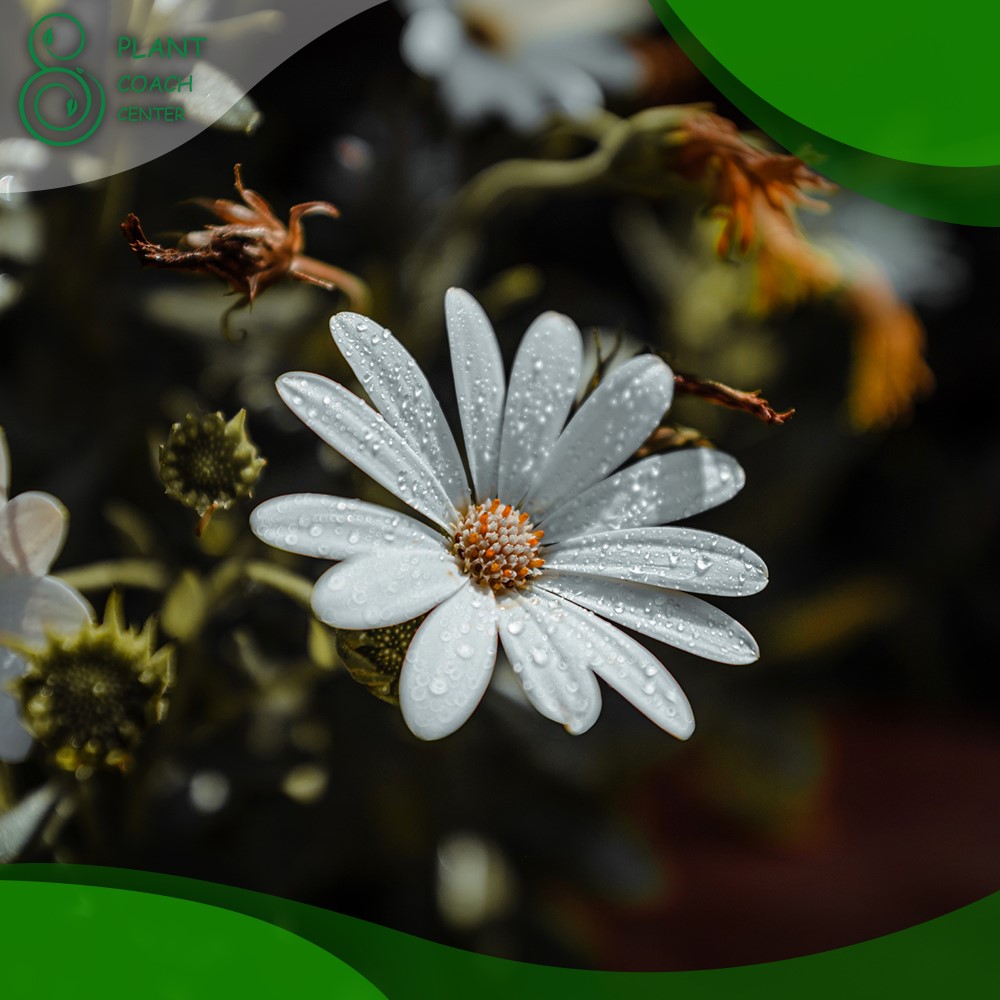When to Cut Back Montauk Daisies
Gardening enthusiasts and plant lovers often find joy in nurturing their green companions. Proper care and maintenance are essential for ensuring healthy growth and vibrant blooms. In this comprehensive guide, we will explore the art of plant coaching and delve into the specific considerations for Montauk daisies. Focusing on the optimal time to cut back these lovely plants, we’ll uncover the secrets to maintaining their beauty and vitality.
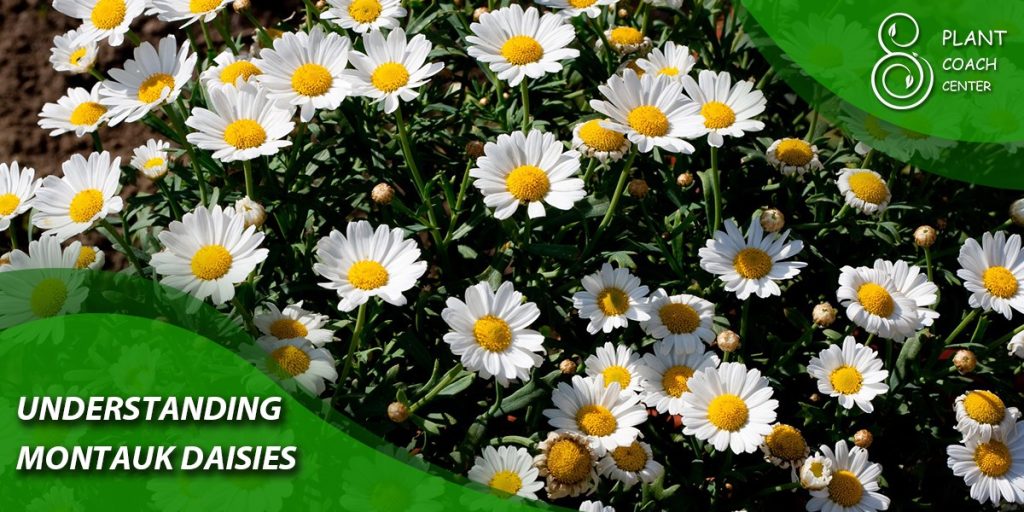
Understanding Montauk Daisies
Montauk daisies, scientifically known as Nipponanthemum nipponicum, are popular perennials cherished for their striking white daisy-like flowers and glossy green foliage. Native to Japan, these plants can reach 3 to 4 feet (0.9 to 1.2 meters) and produce abundant blooms in late summer and fall.
To ensure your Montauk daisies thrive, it’s important to understand their growth requirements. These plants prefer full sun exposure, although they can tolerate partial shade. Well-drained soil enriched with organic matter provides an ideal foundation for their growth. Montauk daisies are also relatively drought-tolerant once established, making them a great addition to gardens with varying water availability.
Seasonal Growth Patterns
Montauk daisies exhibit distinct growth patterns throughout the year. Familiarizing yourself with these seasonal changes will help determine the appropriate timing for pruning and cutting back.
In spring, Montauk daisies emerge from their winter dormancy. New shoots begin to appear, and the plant’s energy is focused on developing lush foliage. During this period, providing the necessary care to support vigorous growth is crucial.
As summer arrives, Montauk daisies continue to flourish. The plants devote their energy to producing buds and preparing for the spectacular display of flowers that awaits in the coming months. The anticipation builds as the buds develop, bringing excitement to the garden.
Finally, in late summer and fall, Montauk daisies peak, showcasing an abundance of radiant white blooms. These flowers add elegance to the landscape and attract pollinators, such as bees and butterflies, creating a lively and enchanting garden.
Benefits of Cutting Back Montauk Daisies
Pruning and cutting back Montauk daisies offer several benefits that contribute to these plants’ overall health and appearance. Let’s explore these advantages in detail:
Encouraging Healthier Growth
Pruning stimulates new growth by removing dead or damaged branches, allowing the plant to redirect its resources towards fresh, vibrant foliage and flowers. It also enhances air circulation, reducing the risk of fungal diseases.
Promoting Bushier and More Compact Plants
Regularly cutting back Montauk daisies helps maintain a neat and compact shape. Pruning encourages lateral branching, resulting in fuller plants with increased flower production.
Enhancing Flower Production
You can maximize flower production by selectively trimming back Montauk daisies. Pruning stimulates the development of new flower buds, leading to a more abundant and captivating display.
Increasing Overall Plant Aesthetics
Well-maintained Montauk daisies contribute to the visual appeal of your garden or landscape. By cutting back the plants at the appropriate times, you can shape them to your liking, ensuring they complement their surroundings and create a harmonious atmosphere.
Factors to Consider Before Pruning
Pruning Montauk daisies requires careful consideration of various factors to ensure optimal results. Before you grab your pruning shears, take the following aspects into account:
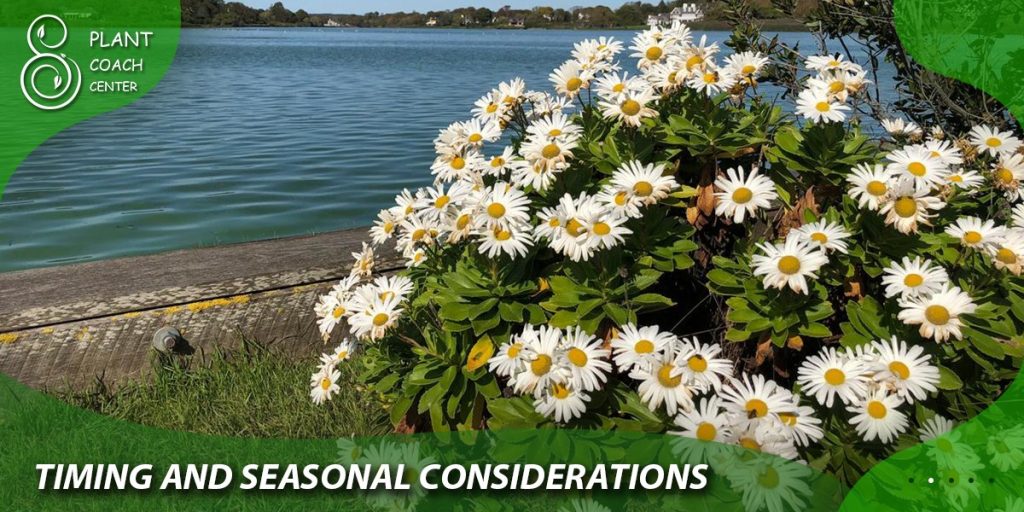
Timing and Seasonal Considerations
The timing of pruning plays a crucial role in the growth and flowering of Montauk daisies. It’s generally recommended to prune these plants at specific times to avoid interfering with their blooming cycle. Pruning during the wrong season may result in a reduction or delay in flower production. We will discuss the appropriate timing for pruning in the upcoming sections.
Weather Conditions and Climate
Weather conditions can influence the success of pruning. It’s advisable to avoid pruning during extremely hot or cold weather, as plants may be more susceptible to stress or damage. Aim to prune when the weather is mild and stable to give your Montauk daisies the best chance to recover and thrive.
Plant Maturity and Health Assessment
Consider your Montauk daisies’ overall health and maturity before pruning. Younger plants may require less drastic pruning, focusing mainly on shaping and encouraging bushier growth. In contrast, older or overgrown plants may benefit from more extensive pruning to rejuvenate them and promote healthier growth.
Identifying Signs for Pruning
Knowing when to prune your Montauk daisies relies on observing specific indicators that suggest the need for pruning. Keep an eye out for the following signs:
Overgrown and Leggy Growth
If your Montauk daisies become tall and leggy with a sparse foliage arrangement, it’s a sign that they may benefit from pruning. Trimming back the plants helps to restore a more compact and well-proportioned form.
Floppy or Weak Stems
Montauk daisies with stems that bend or droop excessively may require pruning. Trimming back weak or floppy stems can improve the plant’s structural integrity and prevent them from falling over or breaking.
Disease or Pest Infestation
If you notice signs of disease, such as discolored or spotted leaves, or if pests have infested your Montauk daisies, pruning affected areas can help control the spread and prevent further damage. Removing infected or infested parts promotes the plant’s overall health and vitality.
Faded or Spent Flowers
Once the flowers on your Montauk daisies have faded or wilted, it’s an indication that they can be pruned. Removing spent flowers improves the plant’s appearance and redirects its energy toward new growth and future blooming.
Pruning Techniques for Montauk Daisies
Pruning Montauk daisies requires a careful approach to ensure the best results. The following pruning techniques are tailored to the different seasons and growth stages of these plants:
Pruning During Dormancy
When Montauk daisies are still dormant in late winter or early spring, it’s an ideal time to perform rejuvenation pruning or remove any dead or damaged branches. Follow these steps:
- Begin by assessing the overall condition of the plant. Identify any dead or diseased branches that need to be removed. These branches will often appear dry, brittle, or discolored.
- Using clean and sharp pruning shears or secateurs, make clean cuts just above a healthy bud or node. Aim for an angled cut to promote healing and prevent water accumulation on the cut surface.
- Consider a more drastic rejuvenation pruning if the plant has become overgrown or leggy. Cut back the entire plant to 4 to 6 inches (10 to 15 cm) above the ground. This helps stimulate new growth and rejuvenate the plant’s form.
- After pruning, clean up any debris around the base of the plant and dispose of it properly to reduce the risk of pests and diseases.
Pruning During Spring Growth:
In early to mid-spring, Montauk daisies begin their active growth phase. At this time, you can shape the plants and promote bushier growth. Follow these steps:
- Assess the plant’s growth and shape. Look for branches growing in undesirable directions or crossing over each other.
- To shape the plant, selectively prune branches back to just above a healthy bud or node. Aim for an outward-facing bud to encourage a more open and well-structured plant.
- Avoid excessive pruning during this stage, as it may reduce the number of flowers that will form later in the season. Focus on minor shaping and removing any weak or overcrowded branches.
- Remember to sanitize your pruning tools before making each cut, especially if you have previously pruned any diseased plants. This helps prevent the spread of pathogens.
Pruning After Flowering:
It’s time for post-flowering pruning after Montauk daisies have finished their blooming cycle in late summer or fall. This helps maintain the plant’s shape and prepares it for the following year. Follow these steps:
- Once the flowers have faded and wilted, trim off the spent flower heads. Use clean pruning shears to make cuts just above a set of healthy leaves or a bud.
- If necessary, shape the plant by selectively pruning branches to maintain a compact and attractive form.
- Avoid cutting back the plant too heavily at this stage, as it may affect the development of new flower buds for the following season.
- Regularly inspect your Montauk daisies during the growing season to identify any signs of disease, pests, or overgrowth that may require targeted pruning.
By following these pruning techniques tailored to each season, you can maintain your Montauk daisies’ health, shape, and overall aesthetics.
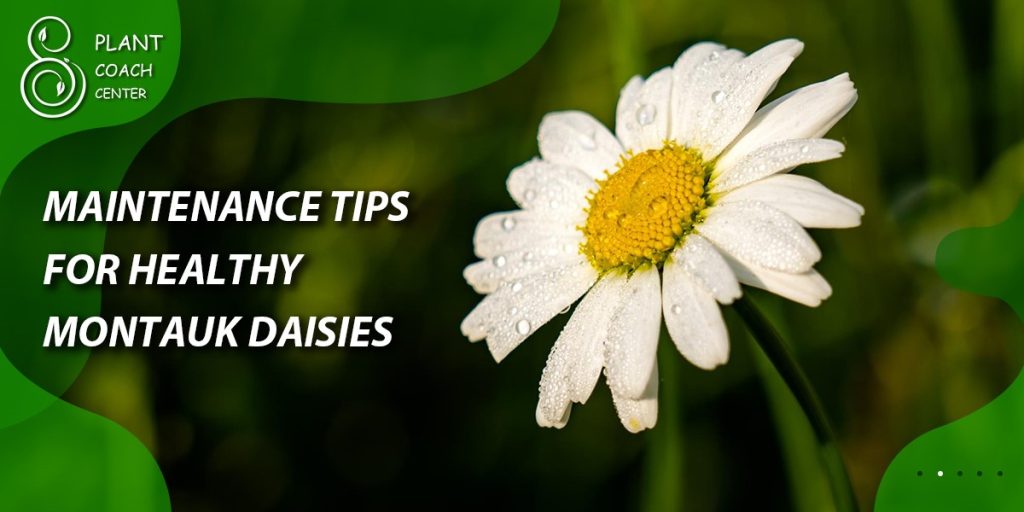
Maintenance Tips for Healthy Montauk Daisies
In addition to proper pruning, regular maintenance practices are vital for ensuring Montauk daisies’ long-term health and vitality. Consider the following tips to keep your plants in optimal condition:
Watering and Fertilization Guidelines
- Montauk daisies prefer well-drained soil, so avoiding overwatering is important. Water the plants deeply but infrequently, allowing the soil to dry slightly between waterings. This helps prevent root rot and other moisture-related issues.
- During hot and dry periods, provide supplemental watering to hydrate the plants. Aim to water at the base of the plant to minimize the risk of fungal diseases.
- Applying a slow-release balanced fertilizer in early spring can provide the nutrients for healthy growth. Follow the manufacturer’s instructions for proper dosage and application methods.
- Avoid overfertilization, as excessive nutrients can lead to leggy growth or reduced flowering. Monitor the plant’s response and adjust the fertilizer application accordingly.
Soil Preparation and Mulching:
- Before planting Montauk daisies, ensure the soil is well-prepared. Loosen the soil and amend it with organic matter, such as compost, to improve drainage and nutrient retention.
- Apply a layer of organic mulch around the base of the plants, leaving a small gap around the stem to prevent moisture-related issues. Mulch helps conserve soil moisture, suppresses weed growth, and regulates soil temperature.
Pest and Disease Prevention:
- Regularly inspect your Montauk daisies for signs of pests, such as aphids, spider mites, or whiteflies. If detected, follow the instructions carefully and employ appropriate pest control methods, such as organic insecticidal soaps or horticultural oils.
- To prevent diseases, provide adequate spacing between plants to promote airflow and reduce humidity around the foliage. Avoid overhead watering, as wet leaves create a favorable environment for fungal diseases.
- Remove and dispose of any diseased or infested plant parts promptly to prevent the spread of pathogens.
Proper Sunlight Exposure:
- Montauk daisies thrive in full sun to partial shade. Ensure they receive at least six hours of direct sunlight daily for optimal growth and flowering.
- Monitor the plant’s exposure to sunlight throughout the day and make adjustments as needed. In regions with intense summer heat, providing partial shade during the hottest day can help prevent stress or sunburn.
Following these maintenance tips can provide the ideal growing conditions and care necessary for your Montauk daisies to flourish.
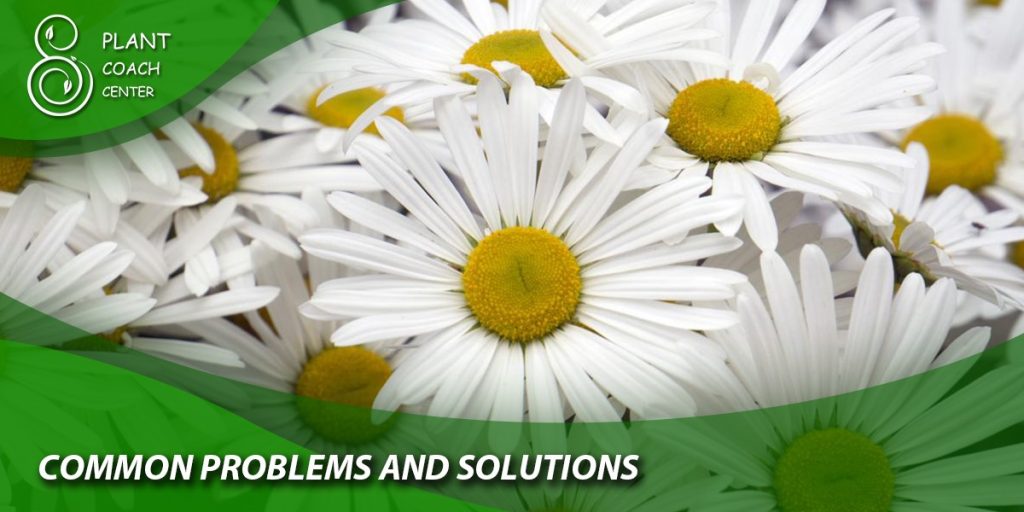
Common Problems and Solutions
Like any other plant, Montauk daisies can face various challenges that may affect their health and vigor. By being proactive and addressing these issues promptly, you can ensure the continued well-being of your plants. Here are some common problems you may encounter and potential solutions:
Pests Affecting Montauk Daisies:
- Aphids: These tiny insects feed on plant sap and can cause distorted growth and yellowing leaves. To control aphids, you can use a strong blast of water to dislodge them from the plant or apply insecticidal soap per the product instructions.
- Spider Mites: Spider mites are common pests that suck the sap from plant tissues, causing yellow stippling and webbing. You can rinse them off the plant with a strong stream of water or use horticultural oil or insecticidal soap specifically formulated for spider mite control.
- Whiteflies: Whiteflies are small, sap-sucking insects that typically congregate on the undersides of leaves, causing yellowing and weakening of the plant. You can use yellow sticky traps or apply insecticidal soap to control whiteflies.
Diseases that may Affect Montauk Daisies:
- Powdery Mildew: Powdery mildew appears as a white, powdery coating on the leaves and stems. To manage powdery mildew, ensure proper air circulation, avoid overhead watering, and apply fungicidal sprays specifically labeled for powdery mildew control.
- Leaf Spot Diseases: Leaf spot diseases manifest as dark spots or lesions on the leaves. Remove and dispose of infected leaves, ensure adequate spacing between plants, and apply copper-based or sulfur-based fungicides according to the product instructions.
- Root Rot: Excessive soil moisture or poor drainage can lead to root rot, causing wilting, yellowing leaves, and stunted growth. Improve soil drainage by amending with organic matter and avoiding overwatering. If root rot is severe, consider transplanting to a well-draining location.
Troubleshooting Other Issues:
- Wilting and Drooping Leaves: Wilting and drooping leaves may indicate underwatering or overwatering. Adjust your watering practices accordingly, ensuring the soil is moist but not soggy. Wilting can also occur due to extreme heat or transplant shock, so provide shade or offer protection until the plant recovers.
- Yellowing or Discolored Foliage: Yellowing or discolored foliage can indicate nutrient deficiencies, such as iron or nitrogen. Test the soil to identify deficiencies and apply appropriate fertilizers or amendments to address the nutrient imbalance.
Remember, early detection and prompt action are key to mitigating problems effectively. Regular monitoring, good cultural practices, and proper care will go a long way in maintaining the health and vitality of your Montauk daisies.
Final thoughts
Proper pruning and maintenance are crucial for the health and beauty of Montauk daisies. By understanding the seasonal growth patterns, identifying signs for pruning, and following the appropriate techniques, you can shape your plants, enhance flower production, and maintain their overall aesthetics.
Additionally, practicing good garden hygiene, monitoring for pests and diseases, and providing optimal watering and fertilization will help keep your Montauk daisies thriving. By addressing common problems promptly and implementing suitable solutions, you can enjoy the full potential of these delightful perennials in your garden.
Remember, each plant is unique, so adapt your care and pruning practices based on the specific needs of your Montauk daisies. With dedication and attention to detail, you’ll create a stunning display of healthy, well-maintained Montauk daisies in your garden.
When is the best time to prune Montauk daisies?
Spring or after flowering in late summer or fall.
How much should I cut back on Montauk daisies?
Remove one-third to one-half of the plant's height for maintenance pruning.
Can Montauk daisies be pruned in the fall?
It's best to avoid fall pruning to preserve flower buds.


